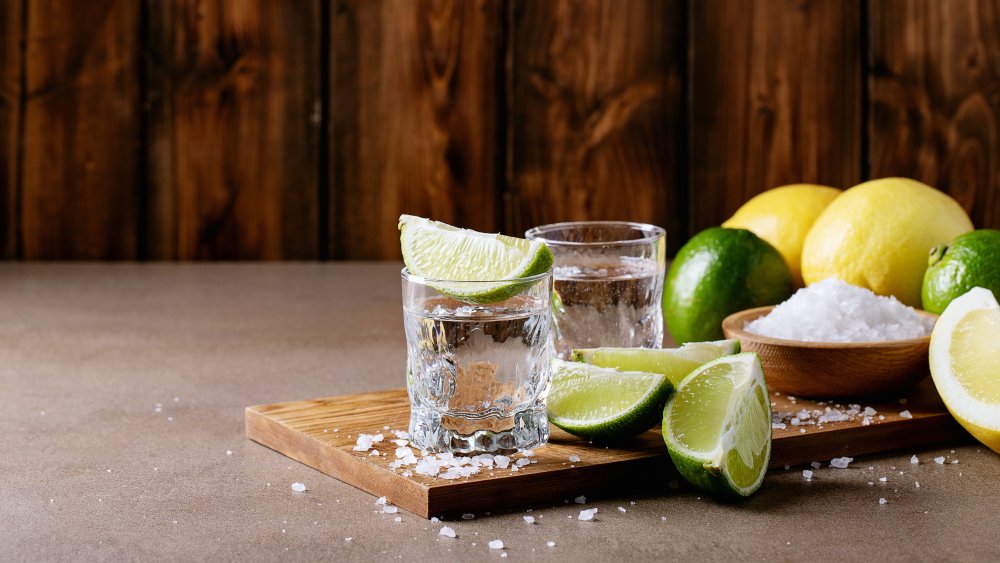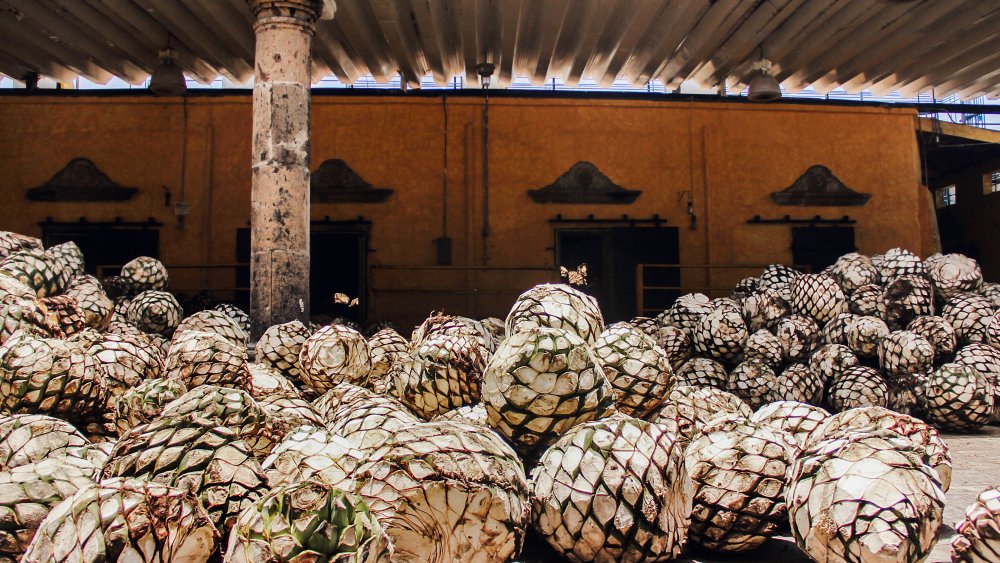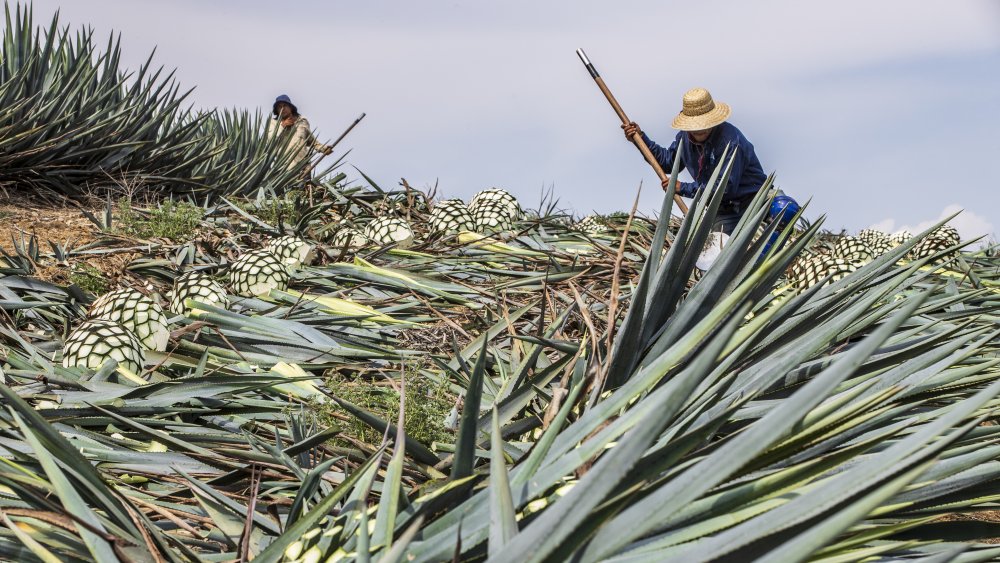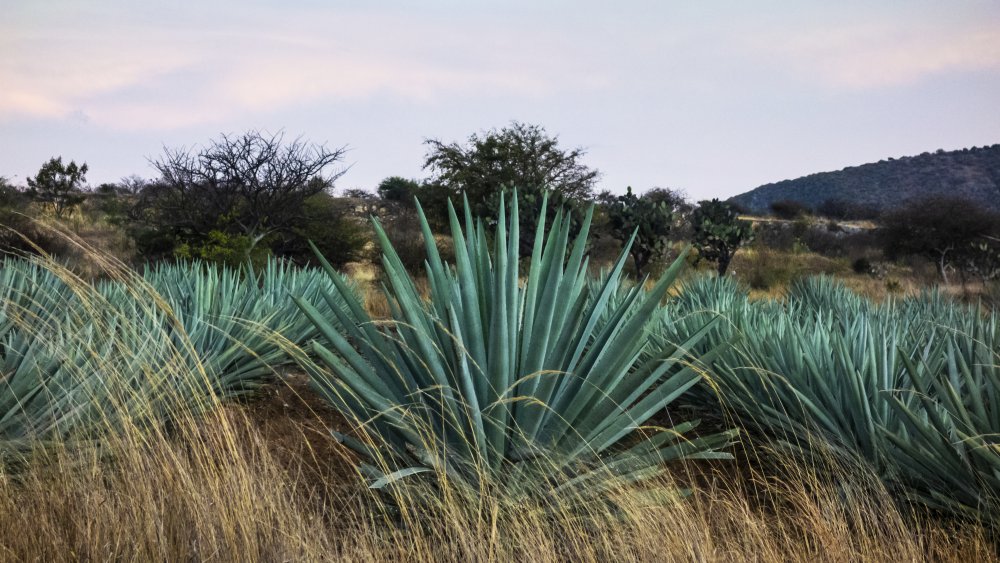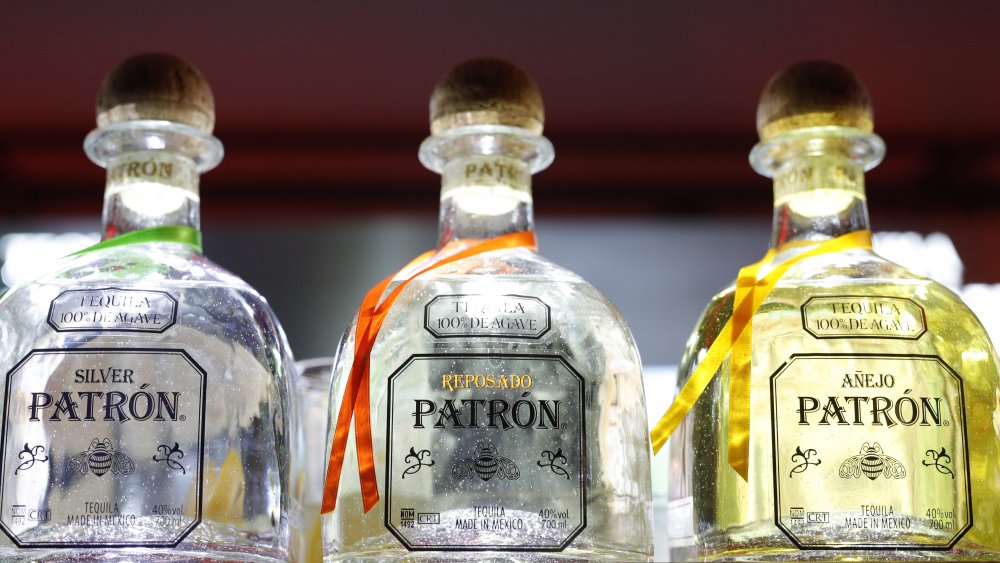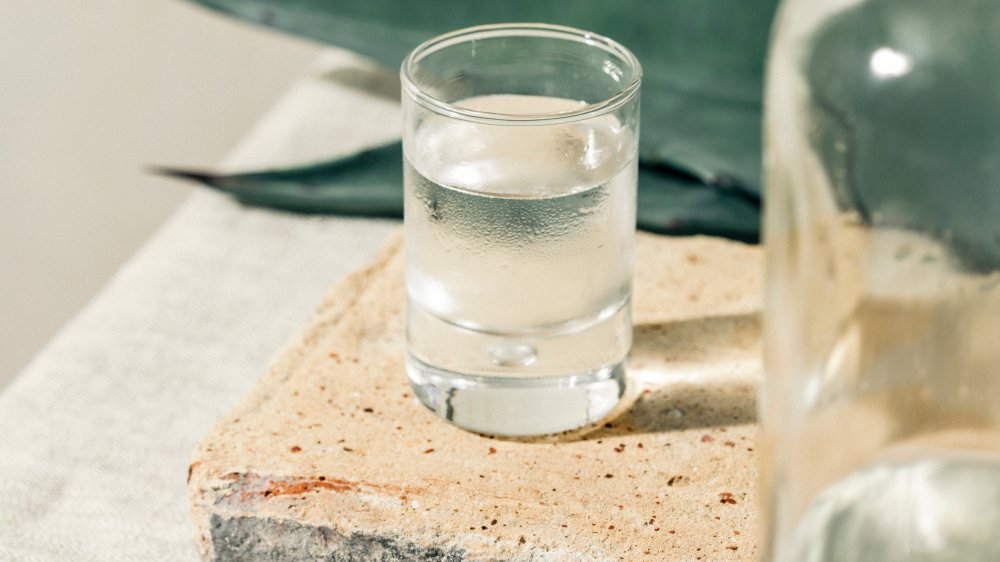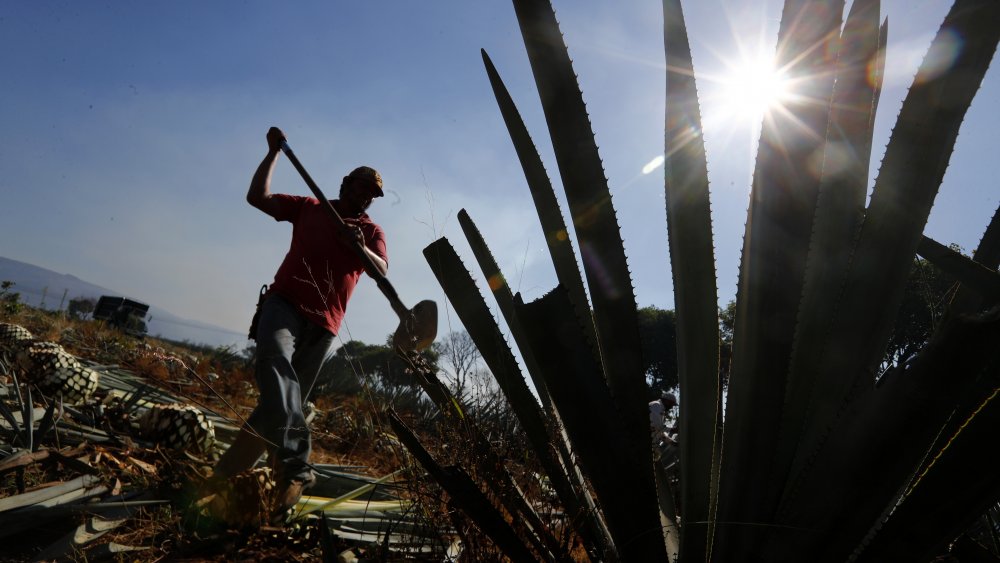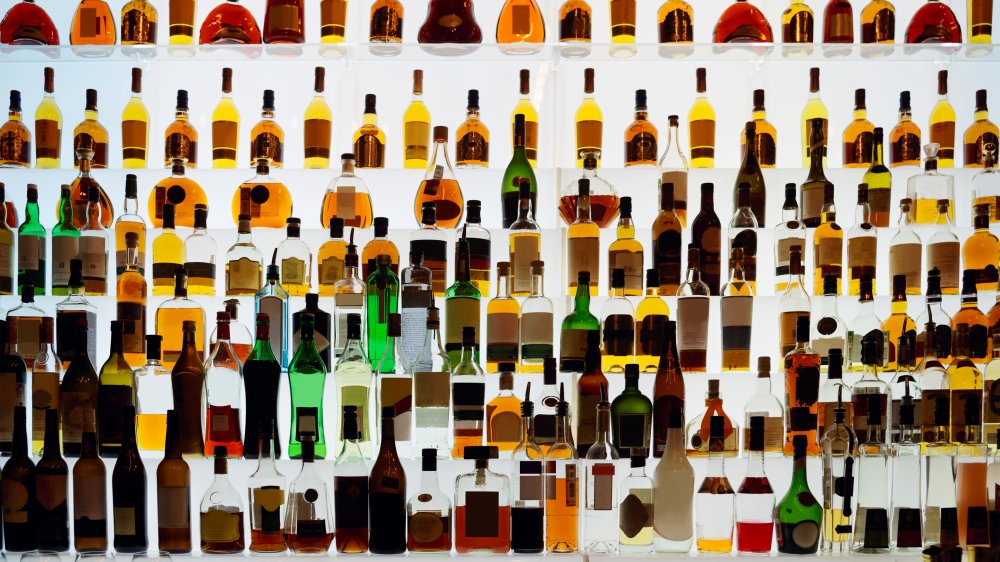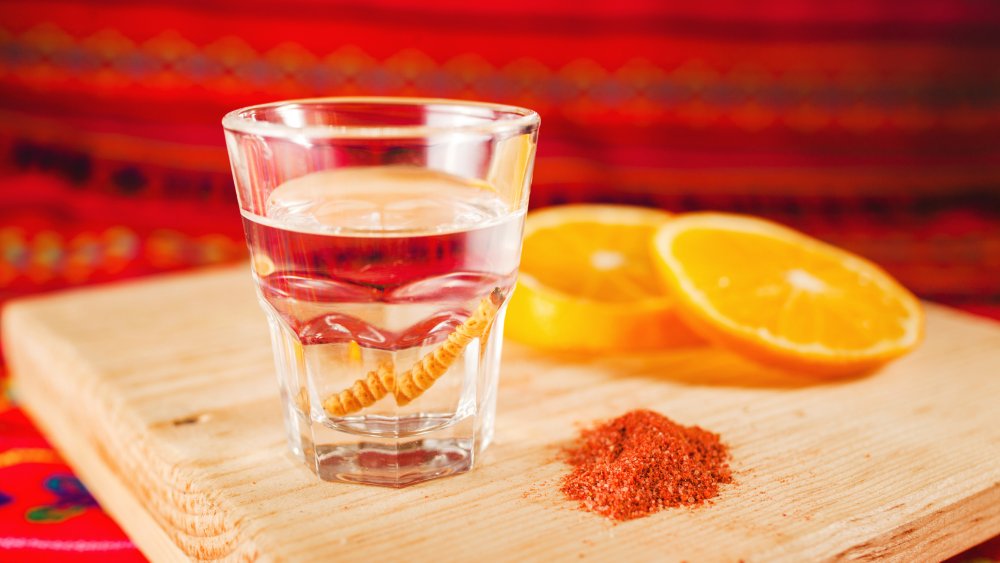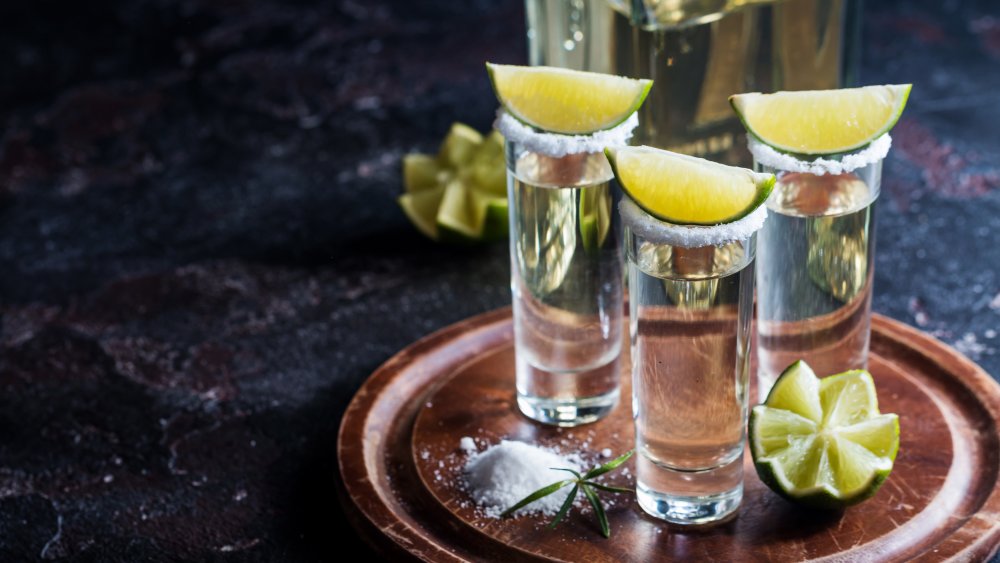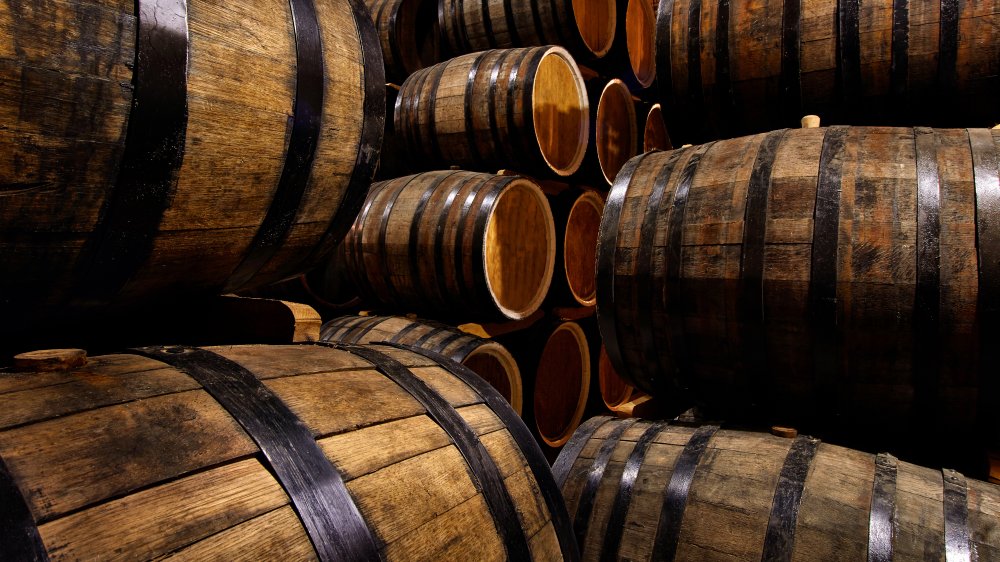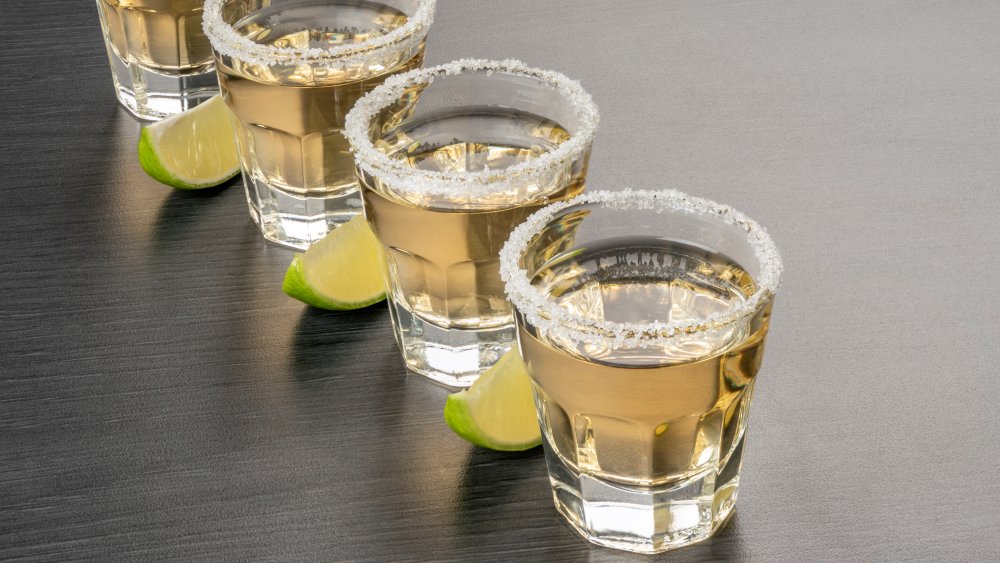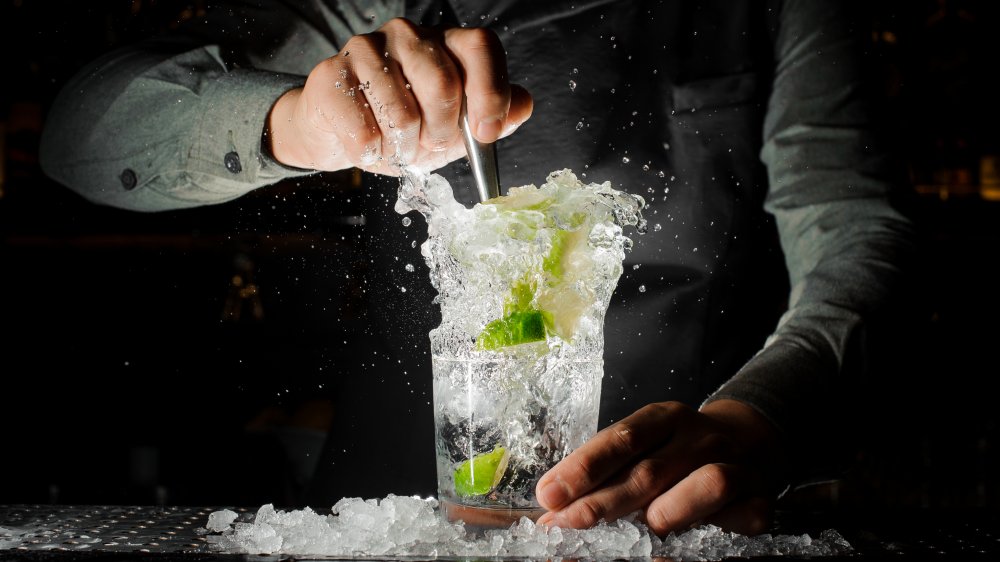What You Should Know Before Taking Another Sip Of Tequila
When it comes to tequila, it's hard not to immediately think of giant frothy margaritas. Or, maybe a whole line-up of salt-rimmed shots on the bar comes to mind (don't forget the lime) and the terrible hangover that consequently follows in the morning. But tequila is so much more than that.
Tequila is wildly popular in the United States, with sales of about 20 million cases in 2019. The tequila industry in the U.S. amounts to $2.9 billion in annual sales, and close to 126 million liters of tequila are consumed just on Cinco De Mayo. Considering how many shots are consumed on that day alone, it's safe to say tequila is a pretty popular alcohol.
Tequila is a spirit with a unique flavor, with earthy notes coming through and a hint of sweetness. And while margaritas and salt-rimmed shots are certainly the most popular way to consume tequila, there's definitely more to this spirit than meets the eye. We decided to dive in and take a look. From the type of plant tequila is made from to the requirements needed to be called a proper tequila, this is everything you need to know before you take another sip of tequila.
Tequila has been around for a very long time
Just like the history of many other spirits on the market, tequila has quite the long, storied past, bringing us the spirit we get to enjoy today.
Stories of the first mention of tequila date back to 1000 BCE when the Olmecs, and later, the Aztecs were fermenting the sap of the agave plant. The drink was prized by the Aztecs and known as pulque. As time went on, Spaniards began to distill agave in the 1400s to replace their depleting supplies of brandy. But each of these variations on the drink was certainly not the same as the tequila we find in stores today, but it was a good enough fix at the time.
When the 1700s rolled around, the concept of commercially distilling tequila officially kicked off. It all began when the Cuervo family decided to go into business in 1758. Another tequila giant, Sauza, followed in 1873 and is credited for trying out blue agave and holding it as the gold standard for making great tequila.
All tequila must be made in Mexico
The vast world of spirits is full of requirements for certain types of spirits to don the names that they do. For bourbon, the drink must actually be made and distilled in the United State to be classified as bourbon. For scotch, it must be made with grain harvested in Scotland and then produced and distilled in the country as well. And tequila follows right along with that same concept.
In order for tequila to truly be called tequila, the spirit must be made in Mexico. But this drink goes even further than just a country requirement. There are very particular locale specifications for tequila as well. For true tequila, the drink must be produced in Jalisco, a state of Mexico. It can also be produced in certain cities including Guanajuato, Michoacán, Nayarit, and Tamaulipas, but that's the extent of it. Anything outside of those areas is not considered true tequila and might fall under the variant category of mezcal instead. That's right — all tequilas are mezcals but not all mezcals can call themselves tequila.
Tequila is technically made from a succulent
Tequila is a very unique spirit when it comes to its base ingredient. Whereas other spirits such as bourbon and scotch are typically made from a grain, such as corn, and even some vodka is made from potatoes, tequila is in its own world.
Tequila is made from Blue Weber Agave, and the popular spirit can only be made from this plant to truly be considered tequila. There are plenty of other varieties of agave that grow throughout Mexico, but for tequila, only Blue Weber will do.
The agave plant is a part of the succulent family of plants. Blue Weber Agave was named by German naturalist Franz Weber in the early 20th century, but it can also be known as agave tequilana. It's a plant that grows rapidly with tall, thin leaves that showcase a cloudy blue-gray color. What sets it apart in the beverage world? It turns out that Blue Weber Agave isn't too herbal, but rather, has a highly unique and sweet taste. "The cooked blue agave juice has a very sweet flavor that I would compare to caramelized pumpkin with hints of citrus and tropical fruits," Tania Oseguera, master tequilier for Tequila Cazadores, explained to Thrillist.
Each type of tequila has a different meaning
When it comes to tequila, not all bottles are one and the same. And yes, certainly there are top-shelf quality tequilas and bottom shelf options. But putting that aside, there are multiple varieties to be aware of when it comes to the production of the spirit.
The types of tequila available typically fall under five main classifications: Blanco (sometimes referred to as Silver), Joven, Reposado, Añejo, and Extra Añejo.
Blanco tequila usually sees no oak or aging in a barrel whatsoever, showcasing the truest flavors of the distilled agave. Reposado tequilas spend anywhere between two months to a year in an oak barrel, which creates a balance to the flavor with a bit of smoothing on the mouthfeel. Joven tequilas are typically a blanco tequila that's had color added, glycerin, or an aged tequila to round it out. Añejo tequila spends one to three years aging in an oak barrel, and extra añejo tequila spends more than three years in the barrel. Often, the longer a spirit spends on oak, the smoother it is, so the añejo type is typically best for sipping.
Tequila is not the same as mezcal
Tequila lives in the same family as another popular spirit, mezcal. But it's important to recognize that while they share similarities, and are in the same family, the spirits are totally different.
As the saying goes, all tequila is technically mezcal, but not all mezcal can be considered tequila. And that all has to do with the type of agave plant being utilized to produce the spirit. Whereas tequila must be made with Blue Weber Agave, mezcal has a whole lot more options. Mezcal can be produced using more than 30 different types of agave including tobalá, tobaziche, and tepeztate.
Mezcal and tequila are also produced in different regions, although both are made in Mexico. Mezcal is typically produced in regions such as Michoacán, Oaxaca, and Tamaulipas. There are certainly similarities in the fact that agave is harvested for the production of the spirit, but mezcal is made using a completely different method altogether, utilizing cooked agave that's cooked in earthen pits and then distilled in clay pots, which gives off the smoky attributes mezcal is known for.
There are multiple steps to making tequila
Tequila certainly is at the top of the list for the number of steps taken to produce the complex spirit. First thing's first, tequila must start with harvested agave — which can take six to 12 years to reach maturity. Agave farmers harvest the plant by hand, cutting the heart of the plant known as the piña. Next, it's cooked for one to two days to break down the sugars and bring out the flavors in the plant. Once the agave is cooked, the plant is pressed and the liquid is extracted. Some distilleries are still using a traditional stone called a tahona to press the plant, which is made out of volcanic stone. The stones are two tons, which are hand-chiseled, making them quite difficult to procure as an investment.
Once the juice has been extracted and added to wood and steel tanks, the yeast is added to start the fermentation process, turning the sugars into alcohol after 24-96 hours. Once fermented, the liquid is distilled two times, and then, depending on the type of tequila, it may be moved to an oak barrel to be aged.
The agave used in the process can also create differences in the finished product. While all tequila must be made in Jalisco, the highlands sit at a higher elevation and get a lot of sun. That means the agave grown in the lowlands gets less sunlight and doesn't have many residual sugars in the plant. Typically, a highland tequila may be more fruity or tropical, whereas as a lowland tequila may be a bit lighter in flavor.
There are numerous labeling requirements for tequila
Tequila has proved to be a pretty complex spirit, from the specific plant being used to the location it's made in, to even the production process. So, it's no shock that such a particular spirit would have some pretty specific labeling requirements for bottling.
First of all, a spirit has to follow all of the stipulations set forth by the Mexican government in order for it to be labeled as tequila. And that of course includes what it's made of and where it was made. Each producer of approved tequila receives what's called a NOM (Norma Oficial Mexicana) number which is then added to each bottle's label to tell what distillery the bottle came from.
The spirit must be made from at least 51% Blue Weber Agave. If the spirit is 100% blue agave, the label must disclose that information, but if it's anything less than 100 percent, the label will say "mixto." Bottling requirements also call for tequila to be bottled at 35 to 55% alcohol by volume, but is normally sold at 35 to 38%, and different countries where the tequila is being sold have different requirements. South Africa requires a minimum of 43% ABV, while the U.S. requires 40% ABV.
No, you shouldn't have a worm in your tequila bottle
When tequila comes to mind, it's hard not to think about the age-old concept of having a little tequila worm hanging out in the bottom of that bottle. We've all be trained to think of it that way, but in reality, it's just a popular myth.
Part of that comes from the confusion between mezcal and tequila. They're certainly similar spirits because of the use of agave in production, but they're not the same drink. The legend typically involves moth larvae that feed off the maguey, or agave, plant. As legend has it, one producer decided to start putting the worm in a finished bottle of mezcal as a marketing ploy to set mezcal apart as the popularity of tequila in the United States was growing. Once producers realized including the worm in the bottle actually changed the flavor of the drink, they quit the practice, but there may still be a few larvae in bottles out there in the world. Either way, they'll be front and center in bottles of mezcal, rather than ever being in tequila.
Yes, you can sip tequila instead of taking shots
There may not be any other spirit out there that inspires the same chanting of "Shots! Shots! Shots!" at a bar quite like tequila does. After all, it's most common to see tequila served up in a shot glass, with a salted rim and a wedge of lime. The salt is supposed to make the tequila burn less, with the sour acid from the lime balancing out the experience and enhancing the tequila's flavors.
And while shooting tequila is certainly still an acceptable option, there may be better ways to enjoy it.
Sipping on a glass of tequila, much like sipping bourbon or scotch, can be an experience on its own. Using a proper tasting glass or even a wine glass is a great way to let the notes of the tequila wake up as you take small sips. It can definitely be a sipping spirit if you learn to accept it as such.
Some tequila can be aged for a really long time
When it comes to spirits like whiskey, aging can be a selling point for a bottle. A whiskey that has been aged for years might hold more value, as there was so much care and technique put into making the product. But that same concept isn't seen as often for tequila, and that is why you may be used to seeing more Blanco tequila than anything else.
If tequila is Reposado, Añejo, or Extra Añejo, it means that it spent some time in a barrel, but even with Extra Añejo, the aging is typically only three to four years. Mexico's climate can be tricky when it comes to aging a spirit, as much of the spirit can evaporate from the barrels. For years, the concept was very uncommon, and the classification of Extra Añejo wasn't even introduced until 2006.
But an aged tequila can still be worth it for a producer, given the complexity it offers. Patrón released a ten-year aged tequila in 2019, a length of aging that doesn't happen often for tequila. Because of the high temperatures it was aged in, it was able to take on a super complex flavor profile, proving that letting tequila age for longer just might make for an incredible drink. Tequila certainly is known for its uses in margaritas, but if you can get your hands on a well-aged option, it just might be worth a sip.
Tequila may have some health benefits
What if we told you that sipping on tequila could actually provide some health benefits? Sounds too good to be true, right? And no, we're not saying that taking shot by shot of tequila with salt and lime will cure your ailments. But a glass every now and then may do some good.
Research has shown that the agave plant that's harvested to make tequila may enhance calcium and magnesium absorption, which can play a huge role in maintaining good bone health. The inulin found in agave may also play a role in aiding digestion by encouraging the growth of good bacteria. According to the Independent, some people even take shots of tequila before eating to boost their metabolism. And for those with anxiety or sleep issues, it may actually help to calm you down. Tequila has the potential to relax and calm nerves, making it easy to unwind with a glass and then nod off to sleep.
Of course, with all of these potential benefits, consumption is moderate. Overconsumption of alcohol still possesses potentially damaging qualities.
Tequila can be used in a cocktail
There's a pretty significant hurdle in place when it comes to ordering tequila at a bar, or a tequila cocktail for that matter. The go-to is usually shots of tequila or a nice margarita, whether it's blended or on the rocks. And while combining tequila, orange liqueur, lime juice, and simple syrup is a perfectly acceptable option, especially all served up in a salt-rimmed glass, there are plenty of other great cocktail recipes out there to make and enjoy with tequila as the star.
A tequila breeze cocktail is a great way to incorporate tequila into a refreshing drink, with tequila, fresh lime juice, pepper, and blue agave syrup. Or, making a traditional Moscow mule and subbing the vodka for tequila, paired with ginger beer and lime juice, is a great twist on a classic. Cocktails like a tequila sunrise, the paloma, and a Bloody Maria are also perfect showcases for the spirit. Tequila can be used as a substitute for many other spirits in cocktail recipes as a straight swap, especially for vodka, as it offers the same concept with more in-depth flavors.
